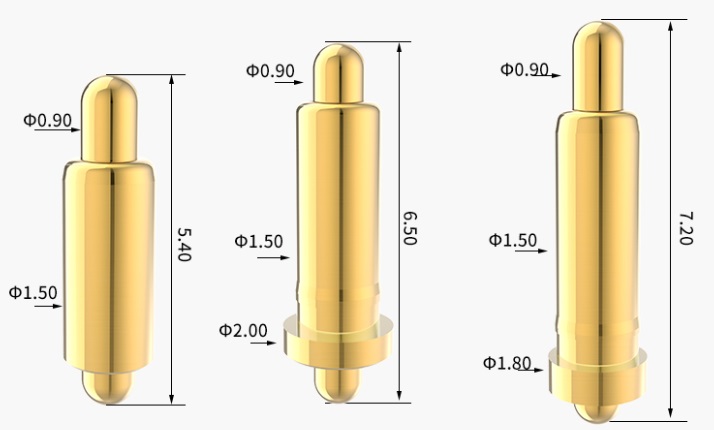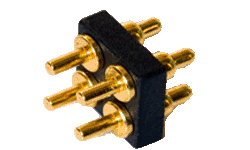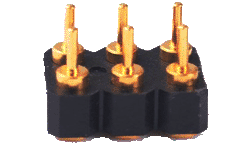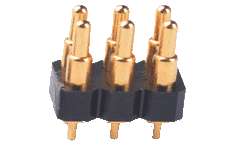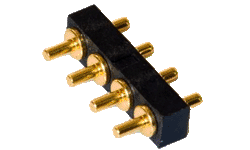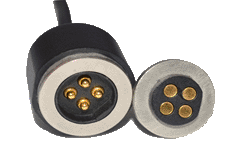2025-7-22 21:20:14
How to design double head Pogo Pin ?
Double Head Pogo Pin, as an important electrical connection component, is widely used in electronic devices to achieve reliable electrical connection and signal transmission. Its design involves several key factors, including material selection, current carrying capacity planning, and surface treatment (such as gold plating). These factors are interrelated and jointly determine the performance and reliability of Double Head Pogo Pin. A deep understanding of its design process is essential to ensure the efficient and stable operation of electronic devices.
Material Selection of double head pogo pin Material
Brass: Brass is widely used in pin materials due to its good conductivity. For example, the common C6801 brass has moderate cost and good processing performance, which can meet the conductivity requirements of most common electronic devices. In some consumer electronic products, such as smartphones and tablets, brass pins can effectively transmit current and signals in internal connections.
Stainless steel: Stainless steel pins are known for their excellent corrosion resistance and are suitable for devices working in harsh environments. For example, in the field of industrial control, equipment may face environments such as humidity and chemical corrosion.
Double Head Pogo Pin with stainless steel pins can maintain stable electrical connections and avoid poor contact caused by corrosion. Like 304 stainless steel, it has good comprehensive performance and is more commonly used in such application scenarios.
Stainless steel spring wire: Stainless steel spring wire is a common material for making Double Head Pogo Pin springs. Taking SUS304 stainless steel spring wire as an example, it has good elasticity and corrosion resistance, can maintain stable performance during multiple compression and rebound processes, provide continuous and stable pressure for the pins, and ensure the tightness of the connection. In application scenarios with frequent plugging and unplugging, such as test fixtures, springs made of stainless steel spring wire can meet the needs of high-frequency use.
High-temperature alloys: When Double Head Pogo Pins are used in high-temperature environments, such as electronic equipment connections in the engine compartment of a car, it is necessary to consider using high-temperature alloy materials to make springs. For example, Inconel alloy can maintain elasticity and mechanical properties at high temperatures, ensuring that the springs can still work normally in high-temperature environments and maintain effective contact between pins.
Pogo pin Base material
Plastic: if production double head
magnetic connector,the Plastic bases are widely used in some electronic devices that do not require high mechanical strength due to their good insulation performance and light weight. For example, in small portable devices such as smart bracelets and wireless headphones, plastic bases can effectively reduce product weight while providing reliable insulation to prevent problems such as short circuits. Common engineering plastics such as polycarbonate (PC) and acrylonitrile-butadiene-styrene copolymer (ABS) can be used as base materials.
Metal: For application scenarios that require high mechanical strength and good thermal conductivity, metal bases are more suitable. In high-power electronic devices, metal bases can better fix Double Head Pogo Pins and conduct away the heat generated during work to avoid affecting device performance due to overheating. Metal materials such as aluminum alloys are often used in such scenarios because of their high strength-to-weight ratio.
Double head pogo pin Current-related design
Considerations: The current carrying capacity of Double Head Pogo Pins mainly depends on the cross-sectional area of the pin and spring, the conductivity of the material, and the contact resistance. The larger the cross-sectional area of the pin and spring, the larger the current allowed to pass; the higher the conductivity of the material, the higher the current transmission efficiency; the smaller the contact resistance, the smaller the energy loss during the current transmission process, which is more conducive to improving the current carrying capacity.
In a certain period of time, in order to ensure that the working temperature of the Pogo Pin is within a reasonable range, the maximum allowable current can be inferred by calculating the heat allowed to be generated. In actual design, a certain safety margin must also be considered. Usually, the calculated current value is multiplied by a coefficient less than 1 (such as 0.8) as the current carrying capacity of the actual design.
Design strategy to meet high current requirements
Increase the cross-sectional area: increase the cross-sectional area by increasing the diameter of the pin and spring or using a special cross-sectional shape (such as flat). For example, in some power connection scenarios that need to carry high current, increasing the pin diameter from the conventional 0.5mm to 1mm can significantly improve the current carrying capacity.
Reduce contact resistance: optimize the contact structure of the pin and spring, and use a special surface treatment process (such as gold plating mentioned later) to improve the flatness and finish of the contact surface to reduce contact resistance. At the same time, ensure the assembly accuracy between the pin and the spring to ensure a good contact state. For example, the pin and spring are processed with precision molds so that the matching accuracy of the two is controlled within ±0.01mm, which can effectively reduce the contact resistance.
The role of double head pogo pin gold-plated design
Improve conductivity: Gold has extremely high conductivity. Gold plating on the surface of the pin can reduce contact resistance and improve current transmission efficiency. Especially in high-frequency signal transmission, low contact resistance can reduce signal attenuation and ensure signal integrity. For example, in the internal connection of 5G communication equipment, the gold-plated Double Head Pogo Pin can meet the requirements of high-speed and low-latency signal transmission.
Enhance corrosion resistance: The chemical properties of gold are stable and it is not easy to react chemically with oxygen, water vapor, etc. in the air. In harsh environments such as humidity, acid and alkali, the gold-plated layer can protect the internal metal materials from corrosion and extend the service life of the Double Head Pogo Pin. For example, in outdoor electronic equipment, such as street light controllers and meteorological monitoring equipment, the gold-plated Pogo Pin can resist the erosion of harsh environments and ensure long-term stable operation.
Self-cleaning function assistance: During the plugging and unplugging process, the smooth surface of the gold-plated layer helps to reduce the adhesion of dirt, oxides, etc. on the contact points, assists in achieving a certain self-cleaning function, and further improves the reliability of the connection.
Double head pogo pin gold plating process selection
Plating thickness: Select the appropriate gold plating thickness according to different application scenarios. In general consumer electronic products, the gold plating thickness is usually between 0.125μm - 0.75μm, which can meet the conventional conductivity and corrosion resistance requirements. In some applications with extremely high reliability requirements, such as aerospace equipment and medical equipment, the gold plating thickness may be increased to 1μm - 3μm to provide more lasting protection and stable electrical performance.
Vacuum blind hole electroplating technology: For some complex structures, such as Double Head Pogo Pin with blind holes, vacuum blind hole electroplating technology can ensure that the gold layer is evenly plated inside the blind hole. This technology can effectively avoid the generation of defects such as bubbles by electroplating in a vacuum environment, ensure the quality and integrity of the gold plating layer, thereby achieving extremely low and stable contact resistance and improving product performance.
Double head pogo pin gold plating quality control
Appearance inspection: Check whether the surface of the gold-plated layer is smooth and uniform, and whether there are defects such as missing plating, blistering, and pitting by visual inspection or with the help of tools such as microscopes. Products with appearance defects need to be reworked or scrapped.
Thickness inspection: Use professional equipment such as X-ray fluorescence spectrometer to accurately measure the thickness of the gold-plated layer to ensure that it meets the design requirements. For products with unqualified thickness, it is necessary to adjust the electroplating process parameters for re-electroplating.
Adhesion test: Use methods such as tape peeling test to detect the adhesion between the gold-plated layer and the base material. Stick the tape on the gold-plated surface, then quickly peel it off to observe whether the gold-plated layer falls off. If the adhesion is not up to standard, it is necessary to optimize the electroplating pre-treatment process, such as strengthening the cleaning and activation steps, to improve the adhesion of the gold-plated layer.
Other key design points
Pogo pin structure design
Bevel structure: The bottom of the Double Head Pogo Pin pin usually adopts a bevel structure. When working, the contact between the inclined surface and the spring generates lateral force, which keeps the contact force between the pin and the inner wall of the needle tube stable, ensuring that the current is mainly transmitted through the gold-plated pin and the needle tube, thereby obtaining a stable and extremely low contact resistance. This inclined surface structure design can effectively maintain the reliability of the connection in the application scenario of frequent plugging and unplugging.
Overall size and shape: Design the appropriate overall size and shape according to the space limitations and connection requirements of the application scenario. In space-constrained devices, such as smart watches and Bluetooth headsets, a compact miniaturized design is adopted; in some scenarios where a large contact area is required to carry a large current, a special shape design may be adopted, such as a flat shape or a structure with an extended contact piece.
Pogo pin durability design
Material fatigue performance considerations: Select materials with good fatigue performance. For example, in the selection of spring materials, in addition to considering elasticity and corrosion resistance, it is also necessary to pay attention to its fatigue life after multiple compression-rebound cycles. Through material testing, ensure that the selected material can meet the plug-in and unplug times requirements in actual applications.
Structural optimization: Optimize the internal structure of the Double Head Pogo Pin to reduce stress concentration points. For example, the design of rounded corners and transitions is used at the connection between the pin and the spring to reduce the risk of material fatigue damage caused by stress concentration during the plugging and unplugging process, thereby improving the durability of the product. Generally speaking, the durability of the optimized Double Head Pogo Pin can reach 10,000 to 1,000,000 plugging and unplugging cycles, and the specific value depends on the application requirements and design level.
The design of Double Head Pogo Pin is a comprehensive process. The material selection determines its basic performance and applicable environment. The current-related design ensures that it can meet the requirements of different electrical loads. The gold-plated design improves the product performance in terms of conductivity and corrosion resistance, while the structural design and durability design further ensure the reliability and life of the product in actual use. In the design process, it is necessary to fully consider the mutual influence between various factors and optimize them according to the needs of specific application scenarios to design Double Head Pogo Pin products with excellent performance, reliability and stability to meet the diverse needs of the growing electronic equipment industry.
